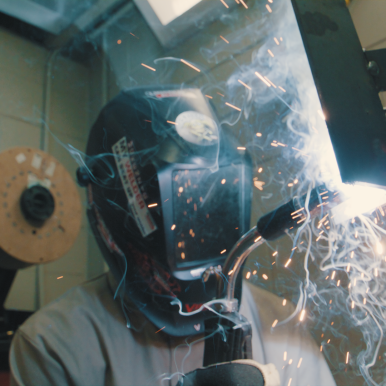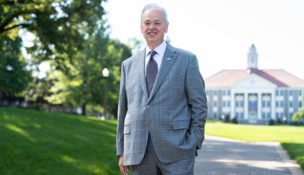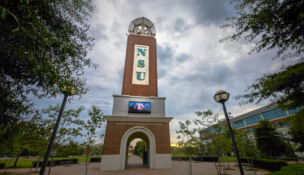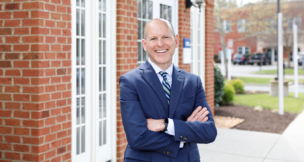Propulsion system
Navy’s silent service makes waves in Danville
Propulsion system
Navy’s silent service makes waves in Danville
Madeline Davis has never set foot on a Navy submarine, so she doesn’t get to see the products she makes in action.
Davis is a CNC (computer numerical control) machinist at Fairlead Integrated in Portsmouth, where she makes metal parts for the Navy’s silent service. The defense contractor supplies shipboard integrated parts, including for the Navy’s Virginia- and Columbia-class nuclear submarines. Davis has worked in her position since May 2022, after she completed a 16-week CNC machining program that March at the Accelerated Training in Defense Manufacturing Program, a Navy-funded, three-year pilot program managed by the Institute for Advanced Learning and Research in her native Danville.
“It taught me exactly what I needed to know,” Davis, 22, says of her experience.
About 200 miles from the sea service’s largest base — Naval Station Norfolk — the program is helping transform Danville from a textile town into a critical player in national security.
ATDM, a public-private partnership between IALR, Danville Community College, the Navy, the Department of Defense and industry stakeholders, is seen as a crucial pipeline to train workers who will be essential to the nation’s defense, particularly in producing parts to repair, upfit, and build nuclear-powered nuclear-powered submarines, in coming decades. In addition to CNC manufacturing, ATDM offers four-month tracks in additive manufacturing, quality control inspection — also known as metrology — and welding. Nondestructive testing (a process by which a material is evaluated without causing damage) was added in January. With ATDM, the Navy is seeking to help meet workforce demands by condensing into four months what might otherwise take a year or two to learn.
The Navy’s nuclear submarine industrial base, which includes 17,000 suppliers and two main shipyards, including Newport News Shipbuilding, expects to need to hire as many as 100,000 workers in the next decade just to build new submarines, says Whitney Jones, who manages the program for Naval Sea Systems Command.
“That is just to build new construction submarines, not the rest of the Navy, not in-service sustaining and service platforms,” Jones says. “It’s a huge number. And when we looked at that number, we were like, OK, technology and the scale of technology is not a nice-to-have; it is an absolute imperative that we go do that.”
ATDM started training its first students in July 2021. As of May, it has produced 217 graduates, says director Debra Holley. Starting this year, it will ramp up to train 528 students, with a goal of graduating 800 to 1,000 students each year by fiscal 2025. For now, students attend the program without charge — though some may be sent by their employers for upskilling while being paid. They also receive free housing and transportation in Danville.
The program recruits nationally and, in addition to the general population, has recruiters who focus on transitioning military members and Afghan refugees who have evacuated to the United States, Holley says. About half of the participants, however, learned about the program through word of mouth, including Davis, who previously worked in retail. Another recent participant came from Texas, where she worked at a convenience store. “She heard about us … came up here, went through our program and then went to the Norfolk Naval Shipyard as a welder,” Holley says.
After applying online, applicants are interviewed and then reviewed by a committee, Holley says. While previous experience isn’t required, motivation is key, she says, adding that the program has recently received about three applications for every available slot.

Dropping anchor
ATDM, which currently has 25 staff members, including 10 instructors, announced plans in early March to fill an additional 38 positions, including 24 instructors, through late summer as it prepares for growth. It plans to hire even more support staff, including recruiters and employment outreach personnel, within the next year. Classes are currently held at IALR and have also previously been taught at DCC. The program is anticipated to move to a new, 100,000-square-foot facility in 2024. The $56 million ATDM Regional Training Center is being funded through a Navy partnership with the DoD’s Industrial Base Analysis and Sustainment program.
As of March, about 45 of ATDM’s 217 graduates have remained in Virginia for work, including some machinists and welders who have been hired by Newport News Shipbuilding, a division of Newport News-based Fortune 500 contractor Huntington Ingalls Industries Inc. The shipyard plans to fill 2,200 skilled trade positions this year and anticipates hiring as many as 19,000 more during the next decade, says shipyard spokesperson Todd Corillo. The nation’s largest builder of military ships is “committed to continuing our participation in future cohorts,” Corillo says, adding it encourages its suppliers in Southern Virginia to take advantage of the program for their hiring needs.
As ATDM grows, so too does another Navy investment in the region. In October 2022, the Navy opened its Additive Manufacturing Center of Excellence (AM CoE) within IALR’s Center for Manufacturing Advancement. That center, adjacent to the future Regional Training Center, is working with industry and academia to grow the Navy’s industrial supplier base by establishing production-ready manufacturing standards and qualifications for 3D-printed submarine parts.
The Navy sees 3D printing as a crucial technology, and it has been testing components for several years. During 2018 and 2019, a metal drain strainer produced by Newport News Shipbuilding was prototyped aboard the Norfolk-based aircraft carrier USS Harry S. Truman. The shipbuilder has subsequently been certified by the Navy to use some 3D-printed metal parts on carriers and submarines.
The Navy’s current supply chain can take as long as 18 months to come up with a crucial part, leading to delays in construction and repair, says Troy Simpson, a member of The Spectrum Group, which is working with ATDM and the AM CoE.
Simpson, who also formerly directed ATDM, says the AM CoE has the potential to turn Danville into the “Silicon Valley” of additive manufacturing.
Given the Navy’s needs and its investments in Danville, it appears to have dropped anchor in the region for the long term. Holley says the program is researching a tuition model if necessary. Jones says the Navy no longer sees the program as a pilot.
“I cannot overemphasize the importance of what we’re going to do down there … [for] national security,” Jones says.
P
















